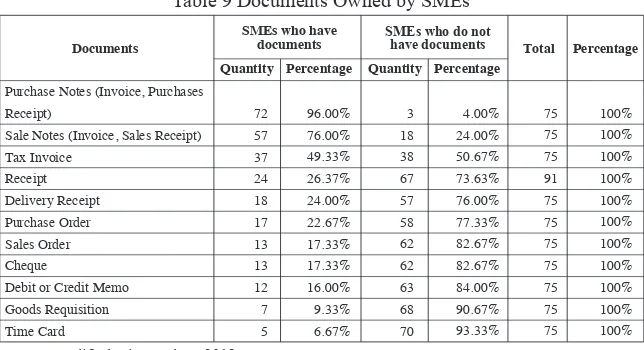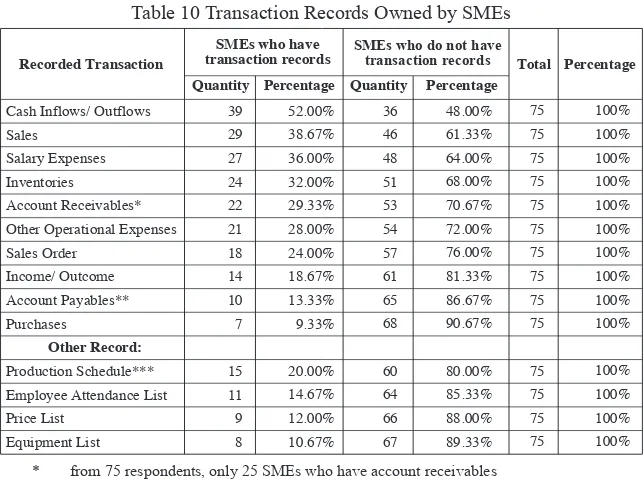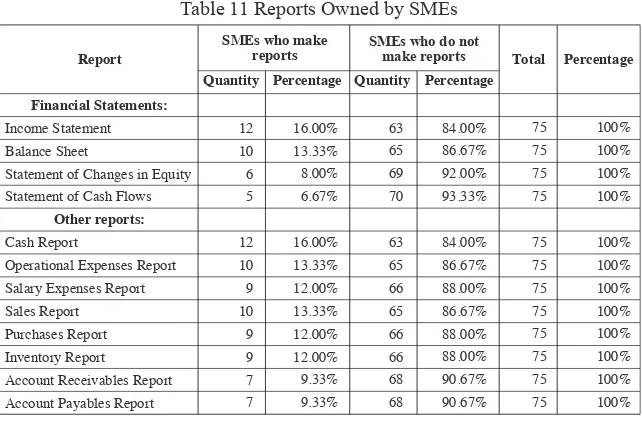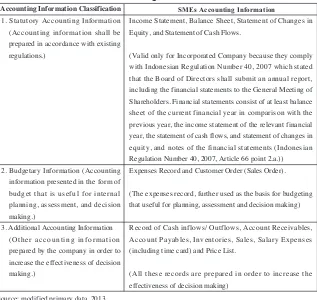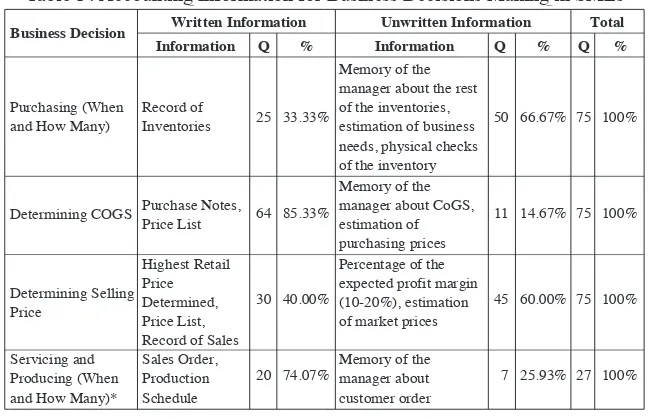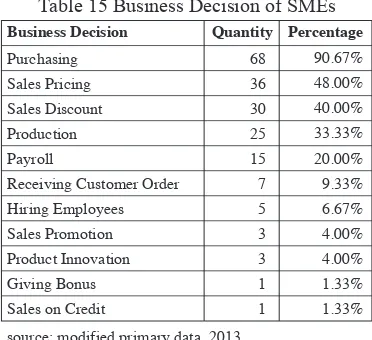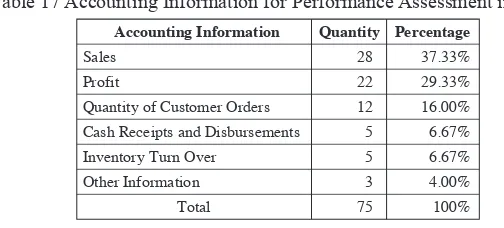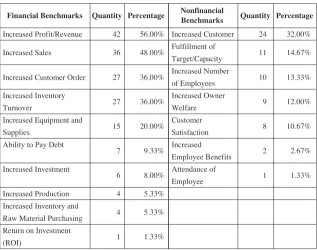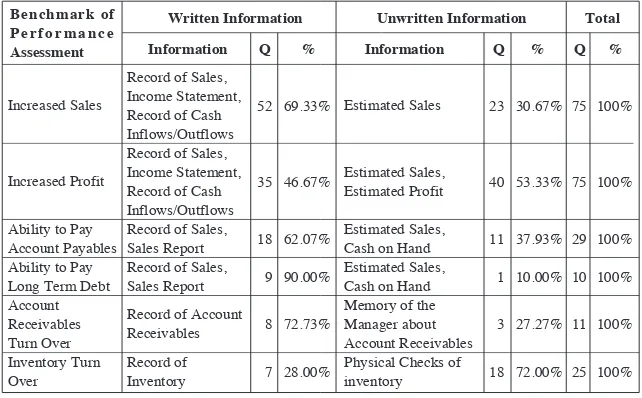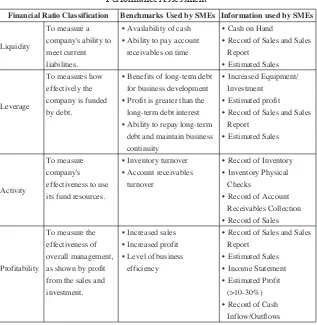67
I. Preface
Small and Medium Enterprises (SMEs) have an important role in Indonesiaʼs economy. According to Musnandar (2012), the fundamental economy of Indonesia is actually supported by small and medium enterprises (SMEs). Therefore, the Indonesian economy is relatively stronger than countries that do not have adequate numbers of SMEs. Statistics have shown that in Indonesia, SMEs make up about 99.8 percent of the total number of business units in Indonesia. Approximately 91.8 million people are involved in SMEs, comprised nearly 97.3 percent of the total Indonesian workforce (Musnandar, 2012). SMEs play a signiicant role in developing Indonesia’s economy because they mostly play very strong roles in real sectors.
By considering the importance of SMEs for Indonesia’s economy, business management of SMEs need more attention. SMEs need qualiied information to improve their business. They need accounting information in daily operations management to support their business decision making and performance assessment. Accounting information can help SMEs to operate eficiently and to evaluate their performance. Eventhough accounting has an important role for SMEs, not all SMEs in Indonesia apply accounting in their business. Based on previous researches, according to Kurniawati and Hermawan (2012) 69.56% of
* Faculty of Economics and Business Satya Wacana Christian University pp. 67-95
Accounting Information for Business
Decision Making and Performance
Assessment in Small and Medium
Enterprises (SMEs)
Elisabeth Penti Kurniawati
Even Yunika Kurniawan
68
SMEs had done recording, but only 34.78% of them made inancial statements. SMEs face various hindrances in applying accounting including the educational factor, knowledge factor, and low level of awareness about the importance of accounting (Kurniawati, Nugroho, and Setiawati, 2011). According to Kurniawati, Nugroho, and Umiyarsih (2011), SMEs have document which is useful for transaction record, but the document is not used as a basis for making a report.
Accounting has an important role in recording and reporting process related to business transactions. Accounting has a role to produce information which is useful for business decision making and performance assessment. The accounting information is resulted from financial reporting process. However based on previous researches, not all SMEs apply accounting and do inancial reporting in their business. Then how SMEs get accounting information and manage their business? This research will explain what kind of accounting information owned by SMEs and how they use it for business decision making and performance assessment.
II. Literature Review 1. Information
According to Considine, Parkes, Olesen, Speer, and Lee (2010), information is data or facts that are processed in a meaningful form. According to Romney and Steinbart (2012), information is processed data used in decision making. Romney and Steinbart (2012) also stated that beneits of information are: reduce uncertainty; improve decisions; improve planning; and improve scheduling. Necessary characteristics of information are:
(1) Relevant: “The capacity of information to make a difference in a decision by helping users to form predictions about the outcomes of past, present, and future events or to conirm or correct prior expectations.”
69
(3) Complete: “The inclusion in reported information of everything material that is necessary for faithful representation of the relevant phenomena.” (4) Timely: “Having information available to a decision maker before it
loses its capacity to inluence decisions.”
(5) Understandable: “The quality of information that enables users to perceive its signiicance.”
(6) Verifiable: “The ability through consensus among measurers to ensure that information represents what it purports to represent or that the chosen method of measurement has been used without error or bias.” (7) Accessible: Available when needed (see timely) and in a useful format
(see understandable) (Romney and Steinbart, 2012).
2. Accounting Information
Warren, Reeve, and Fess (2005) deined accounting as information system that produces reports to the interesting parties about economic activities and companyʼs condition. The primary objective of accounting is to provide information that is useful for decision making purposes. It means that accounting is an information providing activity. Warren, et al. (2005) also stated that the objective of accounting is simply to produce information used by managers to run companyʼs operation. Accounting also gives information to the interesting parties about economic performance and companyʼs condition. According to Considine et al. (2010), accountingʼs role is to gather data about a businessʼs activities, provide a means for the dataʼs storage and processing, and then convert those data into useful information. An accounting system consists of the personnel, procedures, technology, and records used by an organization (1) to develop accounting information and (2) to communicate this information to decision makers (Williams, Haka, Bettner, & Carcello, 2008).
70
matters.
Accounting information is central to many different activities within and beyond an organization (Considine et al., 2010). Accounting information is essential to business operations. According to Williams et al. (2008), the types of accounting information that a company develops vary with such factors as the size of the organization, whether it is publicly owned, and the information needs of management. The types of accounting information required depend on the types of business decision made by management. It means that the role of accounting information is assist manager in making business decisions.
Fiorelli, Zifaro (2008) in Handayani (2011), classified accounting information in to three different types according to the beneits for the users:
1. Statutory Accounting Information is the information shall be prepared in accordance with existing regulations.
2. Budgetary Information is the accounting information presented in the form of budget that is useful for internal planning, assessment, and decision making.
3. Additional Accounting Information is other accounting information prepared by the company in order to increase the effectiveness of decision making.
3. Small and Medium Enterprises
Based on Indonesian Regulation Number 20, 2008 about Micro, Small, and Medium Enterprises in article 1, the deinitions of small and medium enterprises are:
a) Small enterprises is a productive economic activity which is private and owned by an individual, or a business entity that is not a subsidiary or a branch of a company not owned, ruled, or become, directly or indirectly, a part of medium or large business that fulills the criteria of small business as mentioned in this act.
71
branch of a company not owned, ruled, or become, directly or indirectly, a part of medium or large business with net worth or amount of annual sales as provided in this act.
According to the same regulation, the criteria for small and medium enterprises are:
a) Small Enterprises:
1. Net asset is more than IDR 50,000,000 to IDR 500,000,000, but land and building are not included.
2. Annual sale is more than IDR 300,000,000 to IDR 2,500,000,000. b) Medium Enterprises:
1. Net asset is more than IDR 500,000,000 to IDR 10,000,000,000, but land and building are not included.
2. Annual sale is more than IDR 2,500,000,000 to 50,000,000,000.
4. Business Decision
Decision is a reasoned choice among alternatives (Turban and Aronson, 2001). According to Jones and George (2011), decision making is the process by which managers respond to opportunities and threats that confront them by analyzing options and making determinations about speciic organizational goals and courses of action. Thus, it can be said that business decision is a reasoned choice among alternatives respond to opportunities and threats that confront them by analyzing options and making determinations about business goals and courses of action.
According to Romney and Steinbart (2012), businesses engage in a variety of activities. Each activity requires different types of decisions. Each decision requires different types of information. Business decision related to what activities will be accomplished as well as what information is needed.
Romney and Steinbart (2012), stated that there is variation in the degree of structure used to make decisions:
72
(2) Semi Structured Decisions are characterized by incomplete decision making rules and the need for subjective assessments and judgments to supplement formal data analysis.
(3) Unstructured Decisions are non-recurring and non-routine decisions. No frame work or model exists to solve such problems. Instead, they require considerable judgment and intuition.
5. Performance Assessment
A business manager can assess the businessʼs performance using accounting information. Costs, prices, sales volume, proits, and return on investment are all accounting measurements (Williams et al., 2008). Ratio analysis is one of the best tools of business performance assessment. According to Jackson (2004), each ratio provides a certain kind of information when assessing a company. Ratio analysis involves methods of calculating and interpreting inancial ratios to analyze and monitor the firmʼs performance (Gitman & Zutter, 2012). The four categories of ratios to be covered are:
- Liquidity ratios measure a firmʼs ability to meet its current obligations (Gibson, 2011). According to White, Sondhi & Fried (2003), liquidity analysis measures the adequacy of a firmʼs cash resources to meet its near-term cash obligations.
- Leverage ratios measure the extent of a irmʼs inancing with debt relative to equity and its ability to cover interest and other ixed charges (Fraser & Ormiston, 2001).
According to White et al. (2003), long-term debt and solvency analysis: examines the firmʼs capital structure, including the mix of its financing sources and the ability of the firm to satisfy its longer-term debt and investment obligations.
73
Zutter, 2012). According to White et al. (2003), activity analysis evaluates revenue and output generated by the irmʼs assets.
- Proitability ratios measure the earning ability of a irm (Gibson, 2011). According to White et al. (2003), profitability analysis measures the income of the irm relative to its revenues and invested capital.
III. Research Method
Population of this research was Small and Medium Enterprises in Central Java, Indonesia. The samplings used convenience sampling method by choosing SMEs according to Indonesian Regulation number 20, 2008 as the samples and are willing to be interviewed and given questionnaires.
From 100 respondents chosen, 20 companies refused an interview and questionnaires, 5 companies did not meet the criteria which stated in the regulation, and so, there were 75 others left which will be researched furthermore. The sampling was based on rules of the thumb mentioned by J. T. Roscoe (1975), that is the adequate sample measurement ranges from 30-500 (Supramono and Utami, 2003).
Data which was used in this research was primary data from interview and questionnaires results which were given to the SMEs managers. The analysis technique is descriptive quantitative analysis technique.
IV. Data Analysis and Discussion 1. Description of the Research Objects
74
Table 1 Type of Ownership
Table 1 Type of Ownership
source: modified primary data, 2013
Table 2 Age of Business
source: modified primary data, 2013
Table 3 Business Manager
source: modified primary data, 2013
Table 4 Educational Level of Manager
source: modified primary data, 2013 Proprietorship
Type of Ownership Quantity Percentage
0 - 10 years
Age of Business Quantity Percentage
Owner
Business Manager Quantity Percentage
Graduate Undergraduate High School Junior High School Primary School
Type of Ownership Quantity Percentage Table 2 Age of Business
Table 1 Type of Ownership
source: modified primary data, 2013
Table 2 Age of Business
source: modified primary data, 2013
Table 3 Business Manager
source: modified primary data, 2013
Table 4 Educational Level of Manager
source: modified primary data, 2013 Proprietorship
Type of Ownership Quantity Percentage
0 - 10 years
Age of Business Quantity Percentage
Owner
Business Manager Quantity Percentage
Graduate Undergraduate High School Junior High School Primary School
Type of Ownership Quantity Percentage
Most of SMEs managers were the owners (94.67%) and most of them were high school graduates (45.33%) (See table 3 and 4).
Table 3 Business Manager
Table 1 Type of Ownership
source: modified primary data, 2013
Table 2 Age of Business
source: modified primary data, 2013
Table 3 Business Manager
source: modified primary data, 2013
Table 4 Educational Level of Manager
source: modified primary data, 2013 Proprietorship
Type of Ownership Quantity Percentage
0 - 10 years
Age of Business Quantity Percentage
Owner
Business Manager Quantity Percentage
Graduate Undergraduate High School Junior High School Primary School
Type of Ownership Quantity Percentage Table 4 Educational Level of Manager
Table 1 Type of Ownership
source: modified primary data, 2013
Table 2 Age of Business
source: modified primary data, 2013
Table 3 Business Manager
source: modified primary data, 2013
Table 4 Educational Level of Manager
source: modified primary data, 2013 Proprietorship
Type of Ownership Quantity Percentage
0 - 10 years
Age of Business Quantity Percentage
Owner
Business Manager Quantity Percentage
Graduate Undergraduate High School Junior High School Primary School
75
Most of SMEs use their own capital as their source of fund (68.00%) (See table 5). Most of them think that they do not need additional fund from a bank or other inancial institution. They assume as long as they have enough income to run the business they do not need any additional fund. On the other hand, some managers have an unwillingness to take risks if one day they do not have an ability to repay their debt because they cannot predict their proit.
Table 5 Funding Sources
Table 5 Funding Sources
source: modified primary data, 2013
source: modified primary data, 2013
Table 6 Entity Business Concept Application
Table 7 Recording and Reporting Technology
source: modified primary data, 2013
source: modified primary data, 2013 Table 8 Type of Transaction Own Capital
Own Capital and Bank Total
Funding Sources Quantity Percentage
Yes
Apply Business Entity Concept Quantity Percentage
Manual
Technology Used Quantity Percentage
Cash
Cash and Credit Total
Transaction Type Quantity Percentage
Most of SMEs do not apply business entity concept in their business (81.33%) (See table 6). Most of them argued that their business is family business, so they do not need to do so. Even some of them assume that separation between business entity and owner entity will complicate them to use the fund for personal purposes.
Table 6 Entity Business Concept Application
Table 5 Funding Sources
source: modified primary data, 2013
source: modified primary data, 2013
Table 6 Entity Business Concept Application
Table 7 Recording and Reporting Technology
source: modified primary data, 2013
source: modified primary data, 2013 Table 8 Type of Transaction Own Capital
Own Capital and Bank Total
Funding Sources Quantity Percentage
Yes
Apply Business Entity Concept Quantity Percentage
Manual
Technology Used Quantity Percentage
Cash
Cash and Credit Total
Transaction Type Quantity Percentage
76
Table 7 Recording and Reporting Technology
Table 5 Funding Sources
source: modified primary data, 2013
source: modified primary data, 2013
Table 6 Entity Business Concept Application
Table 7 Recording and Reporting Technology
source: modified primary data, 2013
source: modified primary data, 2013 Table 8 Type of Transaction Own Capital
Own Capital and Bank Total
Funding Sources Quantity Percentage
Yes
Apply Business Entity Concept Quantity Percentage
Manual
Technology Used Quantity Percentage
Cash
Cash and Credit Total
Transaction Type Quantity Percentage
Most of SMEs have transaction, both cash and credit (58.67%) (See table 8).
Table 8 Type of Transaction
Table 5 Funding Sources
source: modified primary data, 2013
source: modified primary data, 2013
Table 6 Entity Business Concept Application
Table 7 Recording and Reporting Technology
source: modified primary data, 2013
source: modified primary data, 2013 Table 8 Type of Transaction Own Capital
Own Capital and Bank Total
Funding Sources Quantity Percentage
Yes
Apply Business Entity Concept Quantity Percentage
Manual
Technology Used Quantity Percentage
Cash
Cash and Credit Total
Transaction Type Quantity Percentage
2. Accounting Information Owned by SMEs
Based on the research, SMEs have both, written and unwritten accounting information. The written information which owned by SMEs includes documents, transaction records, and reports. Whereas the unwritten information includes their memories, estimation and third party information they earn from the market, their suppliers and customers.
77
Table 9 Documents Owned by SMEs Table 9 Documents Owned by SMEs
source: modified primary data, 2013
Table 10 Transaction Records Owned by SMEs
* from 75 respondents, only 25 SMEs who have account receivables ** from 75 respondents, only 21 SMEs who have account payables *** from 75 respondents, only 25 SMEs which are manufacturing business source: modified primary data, 2013
Purchase Notes (Invoice, Purchases Receipt)
Sale Notes (Invoice, Sales Receipt) Tax Invoice
Debit or Credit Memo Goods Requisition
Documents Quantity Percentage Quantity Percentage Total Percentage SMEs who have
documents SMEs who do nothave documents
Cash Inflows/ Outflows Sales
Salary Expenses Inventories Account Receivables* Other Operational Expenses Sales Order Employee Attendance List Price List
Recorded Transaction Quantity Percentage Quantity Percentage Total Percentage SMEs who have
transaction records
source: modiied primary data, 2013
Based on the research, SMEs using different accounting information depends on their business characteristics. Sales information is important information for services, merchandising and manufacturing business, therefore, they require document of sale notes (invoices). Especially for services and manufacturing business, customer order is important information. Therefore, they require document of customer order. Services business also requires document of receipt as proof of payment for their customer.
78
Table 10 Transaction Records Owned by SMEs
Table 9 Documents Owned by SMEs
source: modified primary data, 2013
Table 10 Transaction Records Owned by SMEs
* from 75 respondents, only 25 SMEs who have account receivables ** from 75 respondents, only 21 SMEs who have account payables *** from 75 respondents, only 25 SMEs which are manufacturing business source: modified primary data, 2013
Purchase Notes (Invoice, Purchases Receipt)
Sale Notes (Invoice, Sales Receipt) Tax Invoice
Debit or Credit Memo Goods Requisition
Documents Quantity Percentage Quantity Percentage Total Percentage
SMEs who have documents
Cash Inflows/ Outflows Sales
Salary Expenses Inventories
Account Receivables* Other Operational Expenses Sales Order Employee Attendance List Price List
Quantity Percentage Quantity Percentage
Recorded Transaction transaction recordsSMEs who have SMEs who do not havetransaction records Total Percentage
* from 75 respondents, only 25 SMEs who have account receivables ** from 75 respondents, only 21 SMEs who have account payables *** from 75 respondents, only 25 SMEs which are manufacturing business source: modiied primary data, 2013
79
planning and production schedules. Record of account payables and account receivables are important for SMEs which are conduct transactions on credit. These records are useful to control their due date. Record of account payables are made per suppliers and record of account receivables are made per customer. These records facilitate managers to manage their cash.
By doing inancial reporting, managers can control their business. However, based on this study, only a few SMEs did the financial reporting. The results showed that from all SMEs who had done recording, not all of them made financial statement (See table 11). Only a few SMEs made income statement (16.00%) and balance sheet (13.33%). In addition for internal purposes to control their business, SMEs do financial reporting for external purposes to comply requirements from the bank or creditor and for tax purposes. For daily business needs, SMEs made other reports include cash report, expenses report, sales report, purchases report, inventory report, account receivables report and account payables report.
Table 11 Reports Owned by SMEs
Table 12 SMEs Accounting Information Classification
source: modified primary data, 2013
Table 11 Reports Owned by SMEs
source: modified primary data, 2013
1. Statutory Accounting Information (Accounting information shall be prepared in accordance with existing regulations.)
2. Budgetary Information (Accounting information presented in the form of budget that is useful for internal planning, assessment, and decision making.)
3. Additional Accounting Information (Other accounting information prepared by the company in order to increase the effectiveness of decision making.)
Income Statement, Balance Sheet, Statement of Changes in Equity, and Statement of Cash Flows.
(Valid only for Incorporated Company because they comply with Indonesian Regulation Number 40, 2007 which stated that the Board of Directors shall submit an annual report, including the financial statements to the General Meeting of Shareholders. Financial statements consist of at least balance sheet of the current financial year in comparison with the previous year, the income statement of the relevant financial year, the statement of cash flows, and statement of changes in equity, and notes of the financial statements (Indonesian Regulation Number 40, 2007, Article 66 point 2.a.)) Expenses Record and Customer Order (Sales Order).
(The expenses record, further used as the basis for budgeting that useful for planning, assessment and decision making)
Record of Cash inflows/ Outflows, Account Receivables, Account Payables, Inventories, Sales, Salary Expenses (including time card) and Price List.
(All these records are prepared in order to increase the effectiveness of decision making)
Accounting Information Classification Financial Statements:
Income Statement Balance Sheet
Statement of Changes in Equity Statement of Cash Flows
Other reports:
Cash Report
Operational Expenses Report Salary Expenses Report Sales Report Purchases Report Inventory Report
Account Receivables Report Account Payables Report
12
Report Quantity Percentage Quantity Percentage Total Percentage SMEs who make
80
The results showed that most of SMEs only have record of cash inflows/ outlows and/or cash report, it means that they can get information about cash availability that usually provided by Statement of Cash Flows. However the results showed that most of SMEs do not have Income Statement, Balance Sheet, and Statement of Changes in Equity, but they can get accounting information for daily business management. Based on the research, SMEs which do not have Income Statement, they get information of proit from record of sales in comparison with record of expenses, including purchases. Some of SMEs which have only cash transaction they estimate the profit from record of receipts in comparison with record of disbursements. SMEs which do not have Balance Sheet, they get information of asset from record of cash flows, inventory and list of equipment, they also get information of liabilities from record of account payables and bank loan document. SMEs which do not have Statement of Changes in Equity, they estimate the increased equity by increased cash, inventory, equipment, as long as there is no dificulty to pay their liabilities.
81
Accounting Information for Business Decision Making and Performance Assessment in Small and Medium Enterprises (SMEs) Table 12 SMEs Accounting Information Classiication
Table 12 SMEs Accounting Information Classification
source: modified primary data, 2013 source: modified primary data, 2013
1. Statutory Accounting Information (Accounting information shall be prepared in accordance with existing regulations.)
2. Budgetary Information (Accounting information presented in the form of budget that is useful for internal planning, assessment, and decision making.)
3. Additional Accounting Information (Other accounting information prepared by the company in order to increase the effectiveness of decision making.)
Income Statement, Balance Sheet, Statement of Changes in Equity, and Statement of Cash Flows.
(Valid only for Incorporated Company because they comply with Indonesian Regulation Number 40, 2007 which stated that the Board of Directors shall submit an annual report, including the financial statements to the General Meeting of Shareholders. Financial statements consist of at least balance sheet of the current financial year in comparison with the previous year, the income statement of the relevant financial year, the statement of cash flows, and statement of changes in equity, and notes of the financial statements (Indonesian Regulation Number 40, 2007, Article 66 point 2.a.)) Expenses Record and Customer Order (Sales Order).
(The expenses record, further used as the basis for budgeting that useful for planning, assessment and decision making)
Record of Cash inflows/ Outflows, Account Receivables, Account Payables, Inventories, Sales, Salary Expenses (including time card) and Price List.
(All these records are prepared in order to increase the effectiveness of decision making)
Accounting Information Classification SMEs Accounting Information
Financial Statements: Income Statement Balance Sheet
Statement of Changes in Equity Statement of Cash Flows
Other reports: Cash Report
Operational Expenses Report Salary Expenses Report Sales Report Purchases Report Inventory Report Account Receivables Report Account Payables Report
12
Report Quantity Percentage Quantity Percentage Total Percentage
SMEs who make reports
3. Accounting Information for Business Decision Making in SMEs SME managers need accounting information to support their daily business decision making. Results showed that business decision mostly decided by the owner (94.67%) (See table 13).
Table 13 Business Decision Maker in SMEsTable 13 Business Decision Maker in SMEs
source: modified primary data, 2013 Owner
82
SME managers use accounting information both written and unwritten as the basis for their business decisions (See table 14).
Table 14 Accounting Information for Business Decisions Making in SMEsTable 14 Accounting Information for Business Decisions Making in SMEs
* Only for service and manufacturing business source: modified primary data, 2013
Table 15 Business Decision of SMEs
source: modified primary data, 2013 Purchasing (When
and How Many)
Determining COGS
Determining Selling Price
Servicing and Producing (When and How Many)*
Record of Inventories
Purchase Notes, Price List
Highest Retail Price Determined, Price List, Record of Sales Sales Order, Production Schedule
Memory of the manager about the rest of the inventories, estimation of business needs, physical checks of the inventory Memory of the manager about CoGS, estimation of purchasing prices Percentage of the expected profit margin (10-20%), estimation of market prices
Memory of the manager about customer order
Business Decision Written Information Unwritten Information Total
Purchasing Sales Pricing Sales Discount Production Payroll
Receiving Customer Order Hiring Employees Sales Promotion Product Innovation Giving Bonus Sales on Credit
68
Business Decision Quantity Percentage
83
Accounting Information for Business Decision Making and Performance Assessment in Small and Medium Enterprises (SMEs) method. They use written information in the form highest retail price determined by the supplier, price list, and record of sales, and unwritten information in the form percentage of the expected proit margin (usually 10-20%) and estimated of market prices to determine selling price. SME managers use written information in the form sales order, and production schedule, and unwritten information in the form memory of the manager about customer order to decide when and how many service/ product have to be made. Specifically for manufacturing companies, usually most of them have documents/ records regarding the details of the schedule and the amount of production.
The results showed that daily business decisions made mostly related to purchasing, sales pricing, sales discount, production and payroll, etc (See table 15).
Table 15 Business Decision of SMEs * Only for service and manufacturing business source: modified primary data, 2013
Table 15 Business Decision of SMEs
source: modified primary data, 2013 Purchasing (When
and How Many)
Determining COGS
Determining Selling Price
Servicing and Producing (When and How Many)*
Record of Inventories
Purchase Notes, Price List
Highest Retail Price Determined, Price List, Record of Sales Sales Order, Production Schedule
Memory of the manager about the rest of the inventories, estimation of business needs, physical checks of the inventory Memory of the manager about CoGS, estimation of purchasing prices Percentage of the expected profit margin (10-20%), estimation of market prices
Memory of the manager about customer order
Business Decision Written Information Unwritten Information Total
Purchasing Sales Pricing Sales Discount Production Payroll
Receiving Customer Order Hiring Employees Sales Promotion Product Innovation Giving Bonus Sales on Credit
68
Business Decision Quantity Percentage
84
Table 16 Classiication of Business Decision in SMEs
Table 16 Classification of Business Decision in SMEs
source: modified primary data, 2013
Table 17 Accounting Information for Performance Assessment in SMEs
source: modified primary data, 2013 1. Unstructured Decision
2. Semi Structured Decision
3. Structured Decision
a. Business Expansion b. Business Investment a. Sales Promotion b. Product Innovation c. Bonus for Employees d. Sales Discount e. Target of Marketing a. Order Inventories b. Receive Customer Orders c. Pricing Strategy d. Production e. Sales Discount f. Sales on Credit
No. Classification of Business Decision Business Decision in SMEs
Sales Profit
Quantity of Customer Orders Cash Receipts and Disbursements Inventory Turn Over
Other Information
Accounting Information Quantity Percentage
4. Accounting Information for Performance Assessment in SMEs Usually companies evaluate their business performance by using inancial ratios. The results showed that only 1.33% SMEs use the financial ratio for evaluate their business performance, they used Return on Investment (See table 18). They usually used information of sales (37.33%), profit (29.33%) and quantity of customer order (16.00%) to assess their business performance (See table 17).
Table 17 Accounting Information for Performance Assessment in SMEs
Table 16 Classification of Business Decision in SMEs
source: modified primary data, 2013
Table 17 Accounting Information for Performance Assessment in SMEs
source: modified primary data, 2013 1. Unstructured Decision
2. Semi Structured Decision
3. Structured Decision
a. Business Expansion b. Business Investment a. Sales Promotion b. Product Innovation c. Bonus for Employees d. Sales Discount e. Target of Marketing a. Order Inventories b. Receive Customer Orders c. Pricing Strategy d. Production e. Sales Discount f. Sales on Credit
No. Classification of Business Decision
Sales Profit
Quantity of Customer Orders Cash Receipts and Disbursements Inventory Turn Over
Other Information
85
Instead of using financial ratio, SMEs have their own benchmarks for assessing their business performance (See table 18). They use information of increased profit/ revenue, sales, customer order and inventory turnover. Managers of SME also have other benchmarks to help them in assessing performance, such as increased of their equipment and supplies, their ability to pay debt, increased of their investment, production, and purchasing. Performance assessment in SMEs is not only measured by the inancial side, but also the non-inancial side, such as increased customer, fulillment their own target/capacity, increased number of employees, increased owner welfare, customer satisfaction which is measured by increased repeating customer, increased employee beneits and employee’s performance which is measured by their attendance.
Table 18 Financial and Noninancial Benchmarks for Performance Assessment in SMEs
Table 18 Financial and Nonfinancial Benchmarks for Performance Assessment in SMEs
source: modified primary data, 2013 Increased Profit/Revenue
Increased Sales
Increased Customer Order Increased Inventory Turnover
Increased Equipment and Supplies
Ability to Pay Debt
Increased Investment
Increased Production Increased Inventory and Raw Material Purchasing Return on Investment (ROI)
42 36
27
27
15
7
6 4 4
1
56.00% 48.00%
36.00%
36.00%
20.00%
9.33%
8.00% 5.33% 5.33%
1.33%
Financial Benchmarks Quantity Percentage Quantity Percentage
Increased Customer Fulfillment of Target/Capacity Increased Number of Employees Increased Owner Welfare Customer Satisfaction Increased Employee Benefits Attendance of Employee
24 11
10
9
8
2
1
32.00% 14.67%
13.33%
12.00%
10.67%
2.67%
1.33% Nonfinancial
86
SME managers use accounting information both written and unwritten as the basis for their performance assessment benchmarks (See table 19). Based on the table, SME managers use written information in the form record of sales, income statement, record of cash inflows/ outflows, sales report, record of account receivables, record of inventory and unwritten information in the form estimated sales, estimated proit, cash on hand, memory of the manager about account receivables, and physical check of inventory.
Table 19 Written and Unwritten Accounting Information for Performance Assessment Benchmark in SMEs
Table 19 Written and Unwritten Accounting Information for Performance Assessment Benchmark in SMEs
source: modified primary data, 2013 Increased Sales
Increased Profit
Ability to Pay Account Payables Ability to Pay Long Term Debt Account Receivables Turn Over Inventory Turn Over
Record of Sales, Income Statement, Record of Cash Inflows/Outflows Record of Sales, Income Statement, Record of Cash Inflows/Outflows Record of Sales, Sales Report Record of Sales, Sales Report Record of Account Receivables Record of Inventory
Estimated Sales
Estimated Sales, Estimated Profit
Estimated Sales, Cash on Hand Estimated Sales, Cash on Hand Memory of the Manager about Account Receivables Physical Checks of inventory
Written Information Unwritten Information Total
Benchmark of Performance Assessment
87
the long-term debt interest, and ability to repay long-term debt and maintain business continuity for measure their leverage; inventory turnover and account receivables turnover for measure their activity; increased sales, increased proit, and level of business eficiency for measure their proitability (See table 20).
Table 20 Financial Ratio in Comparison with Benchmarks Used by SMEs for Performance Assessment
Table 20 Financial Ratio in Comparison with Benchmarks Used by SMEs for Performance Assessment
source: modified primary data, 2013 To measure a company's ability to meet current liabilities. To measures how effectively the company is funded by debt.
To measure company's effectiveness to use its fund resources.
To measure the effectiveness of overall management, as shown by profit from the sales and investment. Liquidity
Leverage
Activity
Profitability
• Availability of cash • Ability to pay account
receivables on time
• Benefits of long-term debt for business development • Profit is greater than the
long-term debt interest • Ability to repay long-term
debt and maintain business continuity
• Inventory turnover • Account receivables
turnover
• Increased sales • Increased profit • Level of business
efficiency
• Cash on Hand
• Record of Sales and Sales Report
• Estimated Sales • Increased Equipment/
Investment • Estimated profit • Record of Sales and Sales
Report • Estimated Sales
• Record of Inventory • Inventory Physical
Checks
• Record of Account Receivables Collection • Record of Sales
• Record of Sales and Sales Report
• Estimated Sales • Income Statement • Estimated Profit
(>10-30%) • Record of Cash
Inflow/Outflows
88
Obstacles
Based on the results of the study (See table 21), most of SMEs (69.33%) have no problems in recording because they made simple records according with their needs. However, most of SMEs (80%) have obstacles in reporting. Respondents argue that reporting is time-consuming, it is very complicated, whereas their ability is limited.
Most SMEs taken as research object are managed by the owners, so they handle their business directly. According to them, their business can keep running without accounting. Though they realize that without accounting they have limitation of information to manage their business. To overcome this situation, they always conduct direct supervision, perform a physical check for cash and inventory periodically, as well as optimizing their memory and estimates based on their experience to manage their business. Recording and reporting is required as a control, especially when the business is managed by employees.
Table 21 Obstacles of SMEs in Recording and Reporting
Table 21 Obstacles of SMEs in Recording and Reporting
source: modified primary data, 2013 Obstacles in Recording
Obstacles in Reporting
23 60
30.67% 80.00%
52 15
69.33% 20.00%
75 75
100% 100% Obstacles Quantity Percentage Quantity PercentageYes No Total Percentage
V. Closing
1. Conclusion
89
Flows. However the results showed that most of SMEs do not have Income Statement, Balance Sheet, and Statement of Changes in Equity, but they can get accounting information for daily business management. Based on the research, SMEs which do not have Income Statement, they get information of proit from record of sales in comparison with record of expenses, including purchases. Some of SMEs which have only cash transaction they estimate the proit from record of receipts in comparison with record of disbursements. SMEs which do not have Balance Sheet, they get information of asset from record of cash lows, inventory and list of equipment, they also get information of liabilities from record of account payables and bank loan document. SMEs which do not have Statement of Changes in Equity, they estimate the increased equity by increased cash, inventory, equipment, as long as there is no difficulty to pay their liabilities. The accounting information owned by SMEs can be classiied as statutory accounting information, budgetary information and additional accounting information.
The results showed that SMEs use both, written information and unwritten information for business decision making and performance assessment. They use their memories, estimation and third party information they earn from the market, their suppliers and customers as unwritten information. Managers of SME also have other benchmarks to help them in assessing performance, such as increased of their equipment and supplies, their ability to pay debt, increased of their investment, production, and purchasing. Performance assessment in SMEs is not only measured by the inancial side, but also the non-inancial side, such as increased customer, fulillment their own target/capacity, increased number of employees, increased owner welfare, customer satisfaction which is measured by increased repeating customer, increased employee beneits and employeeʼs performance which is measured by their attendance.
2. Suggestion
90
to provide the accounting information that can be used in business decision making and performance assessment. SMEs require document of sale notes (invoices). Services and manufacturing business require document of customer order, services business also requires document of receipt.
Regarding to the ability limitation of SMEs managers, they need a simple bookkeeping which is suitable and easily applied to their business. The results showed that most of the SMEs do not apply double entry bookkeeping, therefore this study suggests recommends some simple basic records that must be owned by the SMEs in the form of a simple single entry bookkeeping in accordance with their own account. SMEs must have at least seven accounts as their business records: (1) cash inlows/ outlows, (2) sales, (3) expenses including purchases, (4) inventory are useful for daily business management; (5) account payables and (6) account receivables are important for SMEs which are conduct transactions on credit; (7) list of equipment are useful for SMEs to keep their ixed asset, must be accompanied with estimation of depreciation expenses to be allocated in the inancial period. Record of customer order is additional record which is important for planning and production or service schedules.
3. Research limitation
The research limitation is the lack of respondentʼs transparency and their understanding in answering the questions. Therefore, this study has limitations in the data accuracy and researcherʼs subjectivity in interpreting the answer of respondents.
4. Future Research
91
References
Considine, B., Parkes A., Olesen K., Speer D., & Lee, M. (2010). Accounting Information System: Understanding Business Processes, 3rd Edition. Milton, Qld: John Wiley & Sons Australia, Ltd Fraser, L. M. & Ormiston, A. (2001), Understanding Financial Statements, 6th Edition, Upper Saddle
River, NJ: Prentice Hall.
Gibson, C. H. (2011). Financial Statement Analysis, 12th
Edition. Norwalk, Connecticut: South-Western Cengage Learning,
Gitman, L. J. & Zutter, C. J. (2012). Principle of Managerial Finance, 13th Edition. Boston: Prentice Hall Pearson Education.
Handayani, B. D. (2011). Affecting Factors on the Use of Accounting Information for Small and Medium Enterprises (SMEs). Jurnal Akuntabilitas (Accounting Scientiic Journals), Vol. 11, No. 1, 50-67.
Indonesian Regulation Number 40 (2007) about Incorporated Company (Undang-Undang Republik Indonesia Nomor 40 Tahun 2007 Tentang Perseroan Terbatas).
Indonesian Regulation Number 20 (2008) about Micro, Small, and Medium Enterprises (Undang-Undang Republik Indonesia Nomor 20 tahun 2008 tentang Usaha Mikro, Kecil dan Menengah) Jackson, H. E. (2004). Accounting and Finance. New York: Foundation Press
Jones, G. R. & George, J. M. (2011). Contemporary Management, 7th
Edition. Boston: McGraw-Hill Higher Education
Jones, K. H., Price, J.B., Werner, M. L., & Doran, M. S. (1996). Introduction to Financial Accounting: A User Perspective. Upper Saddle River, NJ: Prentice Hall.
Kurniawati, E. P. & Hermawan, F. E. P. (2012). Accounting for small and medium enterprises (SMEs). The Journal Contemporary Management Research (Centre for Contemporary Management Research, Bharathidasan Institute of Management), Special Issue 2012, 13-22.
Kurniawati, E. P., Nugroho, P. I., & Setiawati, D. (2011). Penerapan akuntansi untuk Usaha Kecil Menengah (UKM) studi kasus pada usaha dagang Kota Salatiga. Proceeding:“Management: The Next Opportunity and Challenge from Competition to Collaboration” (Institut Manajemen Telkom Bandung), 23-136.
Kurniawati, E. P., Nugroho, P. I., & Umiyarsih, F. (2011). Penerapan akuntansi untuk Usaha Kecil Menengah (UKM). Proceeding: Trend Penelitian Administrasi Bisnis & Manajemen (Universitas Brawijaya Malang), 177-183
Musnandar, A. (2012). Letter: Pay more attention to SMEs. (February, 2012). Retrieved June 13, 2013, from http://www.thejakartapost.com/news/2012/02/14/letter-pay-more-attention-smes. html
Romney, M. B. & Steinbart P. J. (2012). Accounting Information Systems, 12th Edition. Boston: Prentice Hall
Supramono & Utami, I. (2003). Desain Proposal Penelitian. Salatiga: Fakultas Ekonomi Universitas Kristen Satya Wacana.
92
Upper Saddle River, NJ: Prentice Hall.
Warren, C.S., Reeve, J. M., & Fess, P.E. (2005). Accounting, 21st Edition. Australia: Thomson South Western.
White, G. I., Sondhi, A. C., & Fried, D. (2003). The Analysis and Use of Financial Statements, 3rd Edition. Hoboken, NJ: John Wiley & Sons, Inc.
93
<Summary>
Elisabeth Penti Kurniawati Even Yunika Kurniawan Mira Kristiani
Accounting information is an important element for a business which is useful for business decision making and performance assessment. The accounting information is resulted from financial reporting process. However based on previous researches, not all SMEs apply accounting and do inancial reporting in their business. Then how SMEs get accounting information and manage their business? This research will explain what kind of accounting information owned by SMEs and how they use it for business decision making and performance assessment.
Data taken in this research were from 75 SME using convenience sampling method. Data were gathered through interview and questionnaire to the manager of SMEs in Central Java, Indonesia. The analysis technique is descriptive quantitative analysis technique.
The results of this study explains that the accounting information which owned by SMEs in the form of documents, records, and reports. They have purchase and sale receipt as their document, they have record of cash inlows/ outlows and sales also they have simple operational reports, only few of them made financial statement. The results showed that most of SMEs only have cash inflows/ outflows report, it means that they can get information about
Accounting Information For Business Decision Making And Performance
94
cash availability that usually provided by Statement of Cash Flows. However the results showed that most of SMEs do not have Income Statement, Balance Sheet, and Statement of Changes in Equity, but they can get accounting information for daily business management. Based on the research, SMEs which do not have Income Statement, they get information of profit from record of sales in comparison with record of expenses, including purchases. Some of SMEs which have only cash transaction they estimate the proit from record of receipts in comparison with record of disbursements. SMEs which do not have Balance Sheet, they get information of asset from record of cash lows, inventory and list of equipment, they also get information of liabilities from record of account payables and bank loan document. SMEs which do not have Statement of Changes in Equity, they estimate the increased equity by increased cash, inventory, equipment, as long as there is no difficulty to pay their liabilities. The accounting information owned by SMEs can be classiied as statutory accounting information, budgetary information and additional accounting information.
The results showed that SMEs use both, written information and unwritten information for business decision making and performance assessment. They use their memories, estimation and third party information they earn from the market, their suppliers and customers as unwritten information. Managers of SME also have other benchmarks to help them in assessing performance, such as increased of their equipment and supplies, their ability to pay debt, increased of their investment, production, and purchasing. Performance assessment in SMEs is not only measured by the inancial side, but also the non-inancial side, such as increased customer, fulillment their own target/capacity, increased number of employees, increased owner welfare, customer satisfaction which is measured by increased repeating customer, increased employee beneits and employee’s performance which is measured by their attendance.
95
